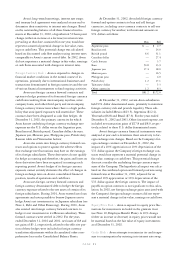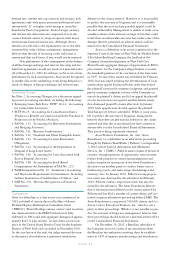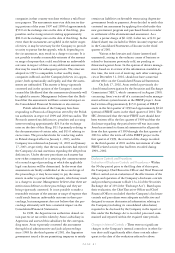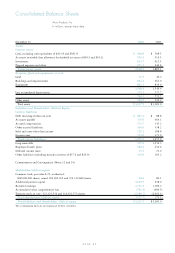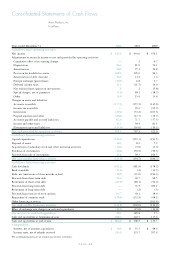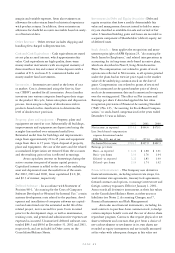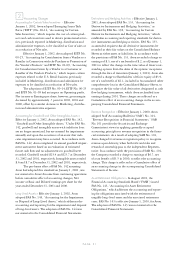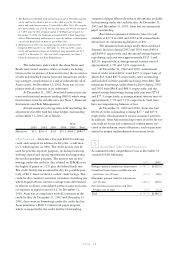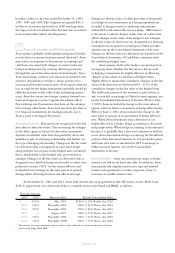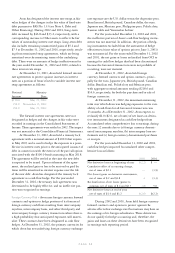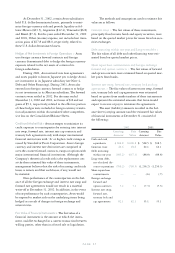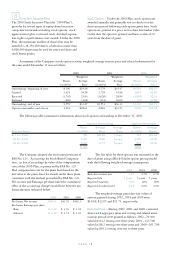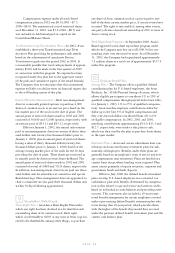Avon 2001 Annual Report Download - page 25
Download and view the complete annual report
Please find page 25 of the 2001 Avon annual report below. You can navigate through the pages in the report by either clicking on the pages listed below, or by using the keyword search tool below to find specific information within the annual report.
PAGE 49
margin and variable expenses. Avon also estimates an
allowance for sales returns based on historical experience
with product returns. In addition, Avon estimates an
allowance for doubtful accounts receivable based on analy-
sis of historical data.
Other Revenue > Other revenue includes shipping and
handling fees charged to Representatives.
Cash and Cash Equivalents > Cash equivalents are stated
at cost plus accrued interest, which approximates fair
value. Cash equivalents are high quality, short-term
money market instruments with an original maturity of
three months or less and consist of time deposits with a
number of U.S. and non-U.S. commercial banks and
money market fund investments.
Inventories > Inventories are stated at the lower of cost
or market. Cost is determined using the first-in, first-
out (“FIFO”) method for all inventories. Avon classifies
inventory into various categories based upon their stage
in the product life cycle, future sales plans and disposition
process. Avon assigns a degree of obsolescence risk to
products based on this classification to determine the
level of obsolescence provision.
Property, plant and equipment > Property, plant and
equipment are stated at cost. Substantially all buildings,
improvements and equipment are depreciated using the
straight-line method over estimated useful lives.
Estimated useful lives for buildings and improvements
range from approximately 20 to 45 years and equipment
range from three to 15 years. Upon disposal of property,
plant and equipment, the cost of the assets and the related
accumulated depreciation are removed from the accounts
and the resulting gain or loss is reflected in earnings.
Avon capitalizes interest on borrowings during the
active construction period of major capital projects.
Capitalized interest is added to the cost of the underlying
asset and depreciated over the useful lives of the assets.
For 2002, 2001 and 2000, Avon capitalized $1.0, $0,
and $2.3 of interest, respectively.
Deferred Software > In accordance with Statement of
Position 98-1, “Accounting for the Costs of Computer
Software Developed or Obtained for Internal Use,” certain
systems development costs related to the purchase, devel-
opment and installation of computer software are capital-
ized and amortized over the estimated useful life of the
related project, not to exceed five years. Costs incurred
prior to the development stage, as well as maintenance,
training costs, and general and administrative expenses are
expensed as incurred. Unamortized deferred software costs
totaled $86.3 and $99.6 at December 31, 2002 and 2001,
respectively, and are included in Other assets on the
Consolidated Balance Sheets.
Investments in Debt and Equity Securities>Debt and
equity securities that have a readily determinable fair
value and management does not intend to hold to matu-
rity are classified as available-for-sale and carried at fair
value. Unrealized holding gains and losses are recorded as
a separate component of Shareholders’ (deficit) equity, net
of deferred taxes.
Stock Awards > Avon applies the recognition and meas-
urement principles of APB Opinion 25, “Accounting for
Stock Issued to Employees,” and related interpretations in
accounting for its long-term stock-based incentive plans,
which are described in Note 8, Long-Term Incentive
Plans. No compensation cost related to grants of stock
options was reflected in Net income, as all options granted
under the plans had an exercise price equal to the market
value of the underlying common stock on the date of
grant. Compensation cost related to grants of restricted
stock is measured as the quoted market price of Avon’s
stock at the measurement date and is amortized to expense
over the vesting period. The effect on Net income and
Earnings per share if Avon had applied the fair value
recognition provisions of Financial Accounting Standard
(“FAS”) No. 123, “Accounting for Stock-Based Compen-
sation,” to stock-based compensation for the years ended
December 31 was as follows.
2002 2001 2000
Net income, as reported $534.6 $444.6 $479.1
Less: Stock-based compensation
expense determined under
FAS No. 123, net of tax (30.1) (27.6) (16.8)
Pro forma Net income $504.5 $417.0 $462.3
Earnings per share:
Basic–as reported $ 2.26 $ 1.88 $ 2.01
Basic–pro forma 2.14 1.76 1.94
Diluted–as reported 2.22 1.85 1.99
Diluted–pro forma 2.10 1.74 1.92
Financial Instruments > The Company uses derivative
financial instruments, including interest rate swaps, for-
ward interest rate agreements, treasury lock agreements,
forward contracts and options, to manage interest rate and
foreign currency exposures. Effective January 1, 2001,
Avon records all derivative instruments at their fair values
on the Consolidated Balance Sheets as either assets or
liabilities (see Notes 2, Accounting Changes, and 7,
Financial Instruments and Risk Management).
Avon also uses financial instruments, including for-
ward contracts to purchase Avon common stock, to hedge
certain employee benefit costs and the cost of Avon’s share
repurchase program. Contracts that require physical or net
share settlement and contracts that give Avon a choice of
net-cash settlement or settlement in its own shares are
recorded as equity instruments and are initially measured
at fair value with subsequent changes in fair value not


